Authors: David M. Lowenstein and Russell L. Groves, UW-Madison, Department of Entomology
Last Revised: 05/06/2020
X-number: XHT1132
Potato leafhopper (PLH), Empoasca fabae, is a potentially serious annual pest of a wide range of plants including, but not limited to, alfalfa, apple, beans (all types), clover, dahlia, eggplant, potato, rhubarb, soybean, strawberry and many types of bedding plants. In Wisconsin, PLH is of particular concern in commercial snap bean and potato production.
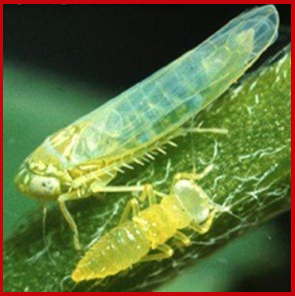
Appearance: The adult PLH is a highly mobile, small (1/8-inch long), bright-green, wedge-shaped insect. Its body is widest at the head and tapers toward the wing tips. A PLH typically has six white spots on the front margin of its prothorax (i.e, the body part to which its first pair of legs is attached). PLH’s have piercing-sucking mouthparts and quickly jump, fly or run sideways when disturbed. PLH nymphs (i.e., immature stages) are smaller than adults, pale green to yellow, and wingless.
Symptoms and Effects:
Adult and nymph PLH’s feed by inserting their mouth parts into a plant’s vascular tissue (specifically the food-conducting tissue called the phloem) and extracting sap. This feeding physically injures the plant. In addition, saliva that PLHs inject into a plant contains toxic compounds, causing further damage. PLH feeding plugs a plant’s vascular tissue and permanently reduces a plant’s ability to efficiently photosynthesize. Typically, nymphs cause more damage than adults.
PLH’s can feed on plants for several weeks before their damage becomes obvious. Symptoms develop most rapidly during hot, dry weather. Initial symptoms of leafhopper feeding include paling of leaf veins and curling of leaves. After continued feeding, a characteristic triangular yellowing or browning of leaf tips (called hopperburn) develops. As symptoms progress, yellowing and browning spread inward from leaf margins, and eventually, entire leaves die. Plants with PLH damage can become stunted and yellow with upward-curled leaves (typical for snap beans). If PLH populations are high, plants can die (typical for potatoes). PLH damage can result in substantial yield loss.
Life Cycle: Potato leafhoppers do not overwinter in Wisconsin. They blow into the state each spring on southerly winds, typically arriving in mid to late May. Female PLHs live approximately one month and lay two to three tiny, white eggs each day in stems and large leaf veins of host plants. Tiny nymphs emerge from these eggs in seven to 10 days, molt five times over a period of approximately two weeks and then turn into adults. There are typically two PLH generations per year in Wisconsin. In June and early July, PLH populations often appear to “explode” overnight, because large numbers of PLHs migrate from alfalfa fields that are harvested at that time. PLH numbers typically decline significantly in August.
Scouting Suggestions:Snap beans and potatoes should be monitored regularly for PLH activity, especially in early summer after alfalfa is cut. For snap beans, PLHs cause their greatest damage when plants are in the seedling stage.
| When to Scout for Leafhoppers | |||||||||||||||
| Crop | May | June | July | August | September | ||||||||||
| Early | Mid | Late | Early | Mid | Late | Early | Mid | Late | Early | Mid | Late | Early | Mid | Late | |
| Bean | X | X | X | X | X | X | X | X | X | X | X | X | X | ||
| Potato | X | X | X | X | X | X | X | X | X | X | X | ||||
If you are a home gardener or a commercial grower, visually inspect susceptible vegetables, particularly snap beans and potatoes, for PLH nymphs. In addition, if you are a commercial vegetable grower, use sticky cards at field edges and sweep nets within fields to monitor for PLH adults. Set up at least five sample sites per 30 acres, and take 25 sweeps per sample site. Also, examine the undersides of 25 leaves at each sample site. Select leaves from the middle to lower half of the plant. See the table below for details on when insecticide treatments should be considered.
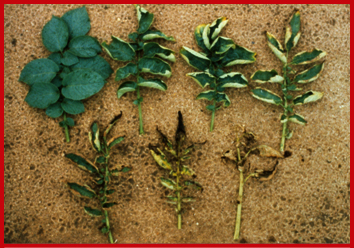
Control:
Cultural: Avoid planting sensitive crops near alfalfa fields, because PLHs will migrate from alfalfa to these crops when the alfalfa field is harvested. Healthy, vigorously growing plants withstand PLH damage more effectively than stressed plants. Therefore, make sure you are watering and fertilizing your plants adequately, as well as following cultural practices (e.g., proper weed control) that reduce plant stress and optimize plant growth.
Several insect predators, fungal pathogens and parasites attack PLHs, although none have been shown to be effective in controlling PLHs. In addition, little information exists on tolerances of different varieties of plants to PLH damage. In snap beans, however, Blue Lake cultivars are known to be more susceptible to PLH damage than Tendercrop lines. Also, vegetable varieties with hairier leaves appear to be less attractive to PLHs and thus less prone to PLH damage.
Chemical: Chemical insecticides provide the most effective control for PLHs. Seed treatments and systemic treatments applied at planting can provide excellent control of PLHs. Many foliar insecticides also provide excellent control. Refer to the University of Wisconsin-Extension publication Commercial Vegetable Production in Wisconsin (A3422) for full list of insecticides and recommendations.
| When to Treat for PLH: Threshold Levels for Selected Vegetables | |||
| Potato Threshold |
Larger Snap Bean Threshold | Potato Threshold |
|
| Nymphs | 1 per 10 leaves | 1 per 10 leaves | 21/2 per 25 leaves |
| Adults | 1 per 2 sweeps | 1 per sweep | 1/2 to 1 per sweep |
For more information on potato leafhoppers: See Extension Bulletin A3422 (Commercial Vegetable Production in Wisconsin) or contact your county Extension agent.
Download Article





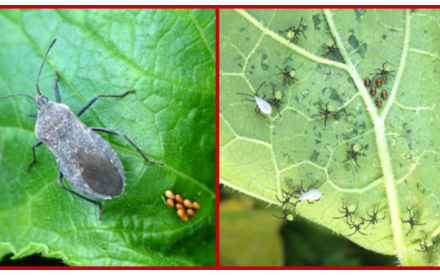 Squash Bug
Squash Bug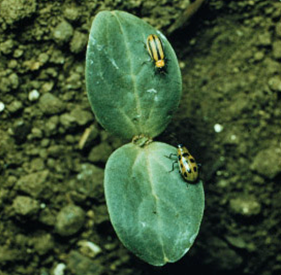 Cucumber Beetles
Cucumber Beetles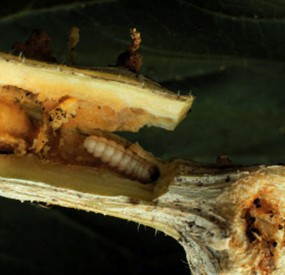 Squash Vine Borer
Squash Vine Borer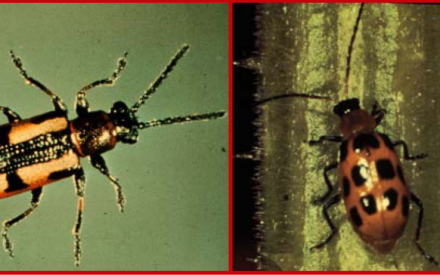 Asparagus Beetle
Asparagus Beetle


